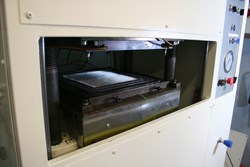Suddenly, automotive composite production abounds
There are at least eight composites manufacturing systems targeting high-volume automotive production.

The automotive industry has long been the Holy Grail of composites manufacturers everywhere, but the complex recipe required to allow carbon fiber composites in particular to move into production vehicles has been daunting. Among the ingredients: Low-cost carbon fiber, reliable carbon fiber supply, design systems that cater to carbon fiber composites, retooling to accommodate carbon fiber, consistent and repeatable part quality, and high-speed manufacturing systems that can provide the hundreds of thousands of units per year part counts found in production carmaking.
The composites industry has not been blind to these demands and is working steadily on all fronts. In particular, equipment and material suppliers have shown, over the last couple of years, a true dedication to high-speed manufacturing systems. At last count, there were in the composites industry at least eight processes either in production or in development that aim to reduce the composites curing process to just minutes. The companies and/or partnerships that CW is aware of include:
- BMW: Resin transfer molding (RTM) of carbon fiber/thermoset composites for the 2013 i3 and 2014 i8; cycle time unknown.
- Plasan Carbon Compostes/Globe Machine: Pressure press molding of carbon fiber/thermoset composite roof and hood for 2014 Corvette Stingray; 17 minutes part-to-part (look for full report in March issue of High-Performance Composites).
- Cannon Group: Carbon fiber/epoxy composites, compression molded, for parts for passenger cell structure for a European automaker; 5 minutes part-to-part. Click here for more on this.
- Teijin/General Motors: Carbon fiber/thermoplastic compression molding process, still in development; 60 seconds part-to-part.
- Dieffenbacher/KraussMaffei: High-pressure RTM (HP-RTM) of carbon fiber/thermoset composite, producing parts for European automaker; 3 minutes part-to-part.
- Gurit: Compression molding of carbon fiber/thermoset composite parts; 10 minutes part-to-part (look for full report in March issue of High-Performance Composites).
- Dow Automotive/Ford: Unkown process; emphasis on development of low-cost carbon fiber.
- Toray/Fuji Heavy Industries: Carbon fiber composites parts for Toyota Lexus; process and cycle time unknown.
One of the big variables here is the definition of "part-to-part." Plasan, for instance, includes layup of the part, which adds to the overall time. Others processes, however, just measure cure time. However it's measured, what's clear is that there are multiple processes that appear to hold great promise for automotive composites.
The question is, what now? Some developers of these processes will tell you that the next hurdle is resin matrix chemistry. What's needed, they say, is a low, low viscosity epoxy with short and adjustable snap cure capabilities. Feedback CW is hearing suggests that resin suppliers are working hard in this direction. Stay tuned.
Related Content
-
Next-gen fan blades: Hybrid twin RTM, printed sensors, laser shock disassembly
MORPHO project demonstrates blade with 20% faster RTM cure cycle, uses AI-based monitoring for improved maintenance/life cycle management and proves laser shock disassembly for recycling.
-
Ceramic matrix composites: Faster, cheaper, higher temperature
New players proliferate, increasing CMC materials and manufacturing capacity, novel processes and automation to meet demand for higher part volumes and performance.
-
Plant tour: Aernnova Composites, Toledo and Illescas, Spain
RTM and ATL/AFP high-rate production sites feature this composites and engineering leader’s continued push for excellence and innovation for future airframes.















